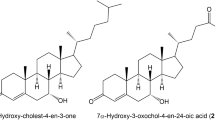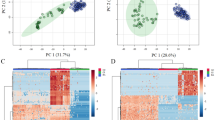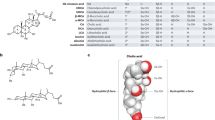Abstract
We report definitive diagnosis and effective chenodeoxycholic acid (CDCA) treatment of two Japanese children with 3β-hydroxy-Δ5-C27-steroid dehydrogenase/isomerase deficiency. Findings of cholestasis with normal serum γ-glutamyltransferase activity and total bile acid concentration indicated the need for definitive bile acid analysis. Large amounts of 3β-hydroxy-Δ5bile acids were detected by gas chromatography-mass spectrometry. HSD3B7 gene analysis using peripheral lymphocyte genomic DNA from the patients and their parents identified four novel mutations of the HSD3B7 gene in the patients. One had a homozygous mutation, 314delA; the other had compound heterozygous mutations: V132F, T149I, and 973_974insCCTGC. Interestingly, the second patient's mother had V132F and T149I mutations in one allele. Excessive 3β-hydroxy-Δ5-bile acids such as 3β,7α-dihydroxy- and 3β,7α,12α-trihydroxy-5-cholenoic acids were detected in the first patient's urine; the second patient's urine contained large amounts of 3β-hydroxy-5-cholenoic acid. Liver dysfunction in both patients decreased with ursodeoxycholic acid treatment, but unusual bile acids were still detected. Normalization of the patients' liver function and improvement of bile acid profiles occurred with CDCA treatment. Thus, we found mutations in the HSD3B7 gene accounting for autosomal recessive neonatal cholestasis caused by 3β-hydroxy-Δ5-C27-steroid dehydrogenase/isomerase deficiency. Early neonatal diagnosis permits initiation of CDCA treatment at this critical time, before the late cholestatic stage.
Similar content being viewed by others
Log in or create a free account to read this content
Gain free access to this article, as well as selected content from this journal and more on nature.com
or
Abbreviations
- 3β-HSD:
-
3β-hydroxy-Δ5-C27-steroid dehydrogenase/isomerase
- Δ5-3β-ol:
-
3β-hydroxy-5-cholenoic acid
- Δ5-3β,7α-diol:
-
3β,7α-dihydroxy–5-cholenoic acid
- Δ5-3β,7α,12α-triol:
-
3β,7α,12α-trihydroxy-5-cholenoic acid
- ALT:
-
alanine aminotransferase
- AST:
-
aspartate aminotransferase
- CA:
-
cholic acid
- CDCA:
-
chenodeoxycholic acid
- Cr:
-
creatinine
- D Bil:
-
direct bilirubin
- GC-MS:
-
gas chromatography-mass spectrometry
- GGT:
-
γ-glutamyltransferase
- T Bil:
-
total bilirubin
- UDCA:
-
ursodeoxycholic acid
References
Clayton PT, Leonard JV, Lawson AM, Setchell KD, Andersson S, Egestad B, Sjövall J 1987 Familial giant cell hepatitis associated with synthesis of 3β,7α-dihydroxy- and 3β,7α,12α-trihydroxy-5-cholenoic acids. J Clin Invest 79: 1031–1038
Buchmann MS, Kvittingen EA, Nazer H, Gunasekaran T, Clayton PT, Sjövall J, Björkhen I 1990 Lack of 3β-hydroxyΔ5-C27-steroid dehydrogenase/isomerase in fibroblasts from a child with urinary excretion of 3β-hydroxy-Δ5-bile acids. J Clin Invest 86: 2034–2037
Schwarz M, Wright AC, Davis DL, Nazer H, Björkhem I, Russell DW 2000 The bile acid synthesis gene 3β-hydroxyΔ5-C27-steroid oxidoreductase is mutated in progressive intrahepatic cholestasis. J Clin Invest 106: 1175–1184
Cheng JB, Jacquemin E, Gerhardt M, Nazer H, Cresteil D, Heubi JE, Setchell KD, Russell DW 2003 Molecular genetics of 3β-hydroxyΔ5-C27-steroid oxidoreductase deficiency in 16 patients with loss of bile acid synthesis and liver disease. J Clin Endocrinol Metab 88: 1833–1841
Fischler B, Bodin K, Stjernman H, Olin M, Hansson M, Sjövall J, Björkhen I 2007 Cholestatic liver disease in adults may be due to an inherited defect in bile acid biosynthesis. J Intern Med 262: 254–262
Terazawa S, Kimura A, Inoue T, Murai T, Kurosawa T, Takao A 1998 An infant with 3β-hydroxyΔ5-C27-steroid dehydrogenase/isomerase deficiency presenting with typical neonatal hepatitis syndrome: the first Japanese case. Acta Paediatr Jpn 40: 638–640
Yamato Y, Kimura A, Murai T, Yoshimura T, Kurosawa T, Terazawa S, Takao A, Maeda K, Nakashima E, Yamashita Y, Kato H 2001 3β-HydroxyΔ5-C27-steroid dehydrogenase deficiency: diagnosis and treatment. J Paediatr Child Health 37: 516–519
Setchell KD, Schwarz M, O'Connell NC, Lund EG, Davis DL, Lathe R, Thompson HR, Weslie Tyson R, Sokol RJ, Russell DW 1998 Identification of a new inborn error in bile acid synthesis: mutation of the oxysterol 7alpha-hydroxylase gene causes severe neonatal liver disease. J Clin Invest 102: 1690–1703
Ueki I, Kimura A, Nishiyori A, Chen H-L, Takei H, Nittono H, Kurosawa T 2008 Neonatal cholestatic liver disease in an Asian patient with a homozygous mutation in the oxysterol 7α-hydroxylase gene. J Pediatr Gastroenterol Nutr 46: 465–469
Tohma M, Mahara R, Takeshita H, Kurosawa T 1986 A convenient synthesis of 3β,12α-, 3β,7α-, and 3β,7β-dihydroxy-5-cholen-24-oic acids: unusual bile acids in human biological fluids. Steroids 48: 331–338
Kimura A, Mahara R, Inoue T, Nomura Y, Murai T, Kurosawa T, Tohma M, Noguchi K, Hoshiyama A, Fujisawa T, Kato H 1999 Profile of urinary bile acids in infants and children: developmental pattern of excretion of unsaturated ketonic bile acids and 7β-hydroxylated bile acids. Pediatr Res 45: 603–609
Sundaram SS, Bove KE, Lovell MA, Schol RJ 2008 Mechanisms of disease: inborn errors of bile acid synthesis. Nat Clin Pract Gastroenterol Hepatol 5: 456–468
Kobayashi M, Koike M, Sakiyama M, Okuda S, Okuda M, Tanaka T, Unno A, Nittono H, Takei H, Murai T, Yoshimura T, Kurosawa T 2000 3β-Hydroxy-Δ5-C27 dehydrogenase/isomerase deficiency in a 23-year-old woman. Pediatr Int 42: 685–688
Gustafsson J 1986 Bile acid biosynthesis during development: hydroxylation of C27-sterols in human fetal liver. J Lipid Res 27: 801–806
Ishibashi S, Schwarz M, Frykman PK, Herz J, Russell DW 1996 Disruption of cholesterol 7α-hydroxylase gene in mice. I. Postnatal lethality reversed by bile acid and vitamin supplementation. J Biol Chem 271: 18017–18023
Schwarz M, Lund EG, Setchell KD, Kayden HJ, Zerwehk JE, Björkhem I, Herz J, Russell DW 1996 Disruption of cholesterol 7α-hydroxylase gene in mice. II. Bile acid deficiency is overcome by induction of oxysterol 7α-hydroxylase. J Biol Chem 271: 18024–18031
Ichimiya H, Nazer H, Gunasekaran T, Glayton P, Sjövall J 1990 Treatment of chronic liver disease caused by 3β-hydroxy-Δ5-C27 dehydrogenase deficiency with chenodeoxycholic acid. Arch Dis Child 65: 1121–1124
Ichimiya H, Egestad B, Nazer H, Baginski ES, Clyton PT, Sjövall J 1991 Bile acids and bile alcohols in a child with hepatic 3β-hydroxy-Δ5-C27 dehydrogenase deficiency: effect of chenodeoxycholic acid treatment. J Lipid Res 32: 829–841
Jacquemin E, Setchell KD, O'Connell NC, Estrada A, Maggiore G, Schmitz J, Hadchoael M, Bernard O 1994 A new cause of progressive intrahepatic cholestasis: 3β-hydroxy-C27 dehydrogenase/isomerase deficiency. J Pediatr 125: 379–384
Subramaniam P, Clayton PT, Portmann BC, Mieli-Vergani G, Hadžić N 2010 Variable clinical spectrum of the most common inborn error of bile acid metabolism-3β-hydroxy-Δ5-C27-steroid dehydrogenase deficiency. J Pediatr Gastroenterol Nutr 50: 61–66
Jacquemin E, Gerhardt M, Cresteil D, Fabre M, Taburet AM, Hadchouel M, Trivin F, Setchell KD, Bernard O 2001 Long-term effects of bile acid therapy in children with defects of primary bile acid synthesis: 3β-hydroxy-C27-steroid-dehydrogenase/isomerase and Δ4-3-oxosteroid 5β-reductase deficiencies. In: von Berge Henegouwen GP, Keppler D, Leuschner U, Paumgartner G, Stiehl A (eds) Biology of Bile Acids in Health and Disease. Kluwer Academic Publishers, Dordrecht, The Netherlands, pp 278–282
Gonzales E, Gerhardt MF, Fabre M, Setchell KD, Davit-Spraul A, Vincent I, Heubi JE, Bernard O, Jacquemin E 2009 Oral cholic acid for hereditary defects of primary bile acid synthesis: a safe and effective long-term therapy. Gastroenterology 137: 1310–1320
Makishima M, Okamoto AY, Repa JJ, Tu H, Learned MR, Luk A, Hull MV, Lustig KD, Mangelsdorf DJ, Shan B 1999 Identification of a nuclear receptor for bile acid. Science 284: 1362–1365
Parks DJ, Blanchard SG, Bledsoe RK, Chandra G, Consier TG, Kliewer SA, Stimmel JB, Willson TM, Zavacki AM, Moore DD, Lehmann JM 1999 Bile acids: natural ligands for an orphan nuclear receptor. Science 284: 1365–1368
Ellis E, Axelson M, Abrahamsson A, Eggertsen G, Thörne A, Nowak G, Ericzon B-G, Björkhem I, Einarsson C 2003 Feedback regulation of bile acid synthesis in primary human hepatocytes: evidence that CDCA is the strongest inhibitor. Hepatology 38: 930–938
Author information
Authors and Affiliations
Corresponding author
Rights and permissions
About this article
Cite this article
Mizuochi, T., Kimura, A., Ueki, I. et al. Molecular Genetic and Bile Acid Profiles in Two Japanese Patients With 3β-Hydroxy-Δ5-C27-Steroid Dehydrogenase/Isomerase Deficiency. Pediatr Res 68, 258–263 (2010). https://doi.org/10.1203/PDR.0b013e3181eb0188
Received:
Accepted:
Issue date:
DOI: https://doi.org/10.1203/PDR.0b013e3181eb0188
This article is cited by
-
Bile Acid Synthesis Disorders in Japan: Long-Term Outcome and Chenodeoxycholic Acid Treatment
Digestive Diseases and Sciences (2021)
-
Two neonatal cholestasis patients with mutations in the SRD5B1 (AKR1D1) gene: diagnosis and bile acid profiles during chenodeoxycholic acid treatment
Journal of Inherited Metabolic Disease (2013)



